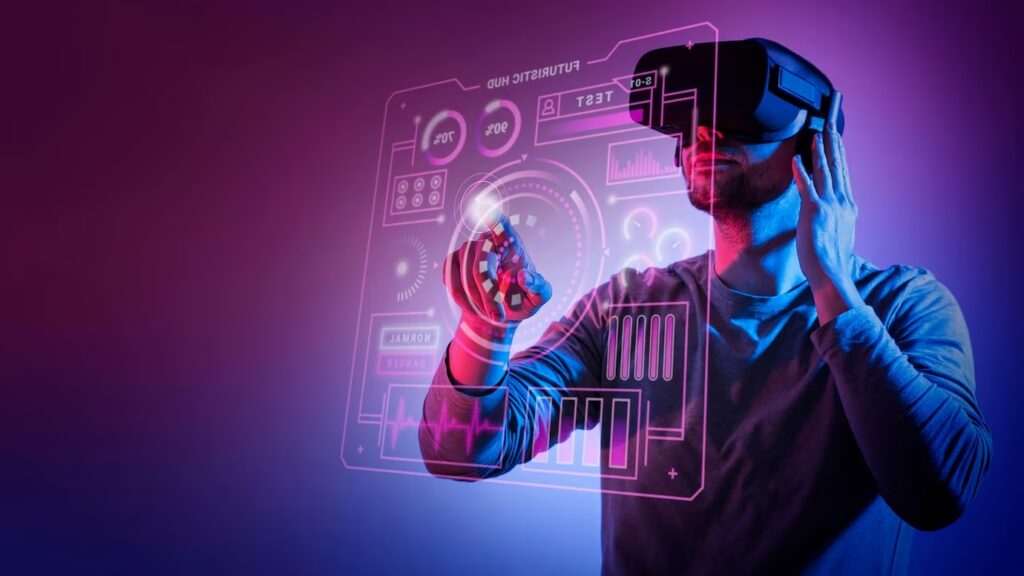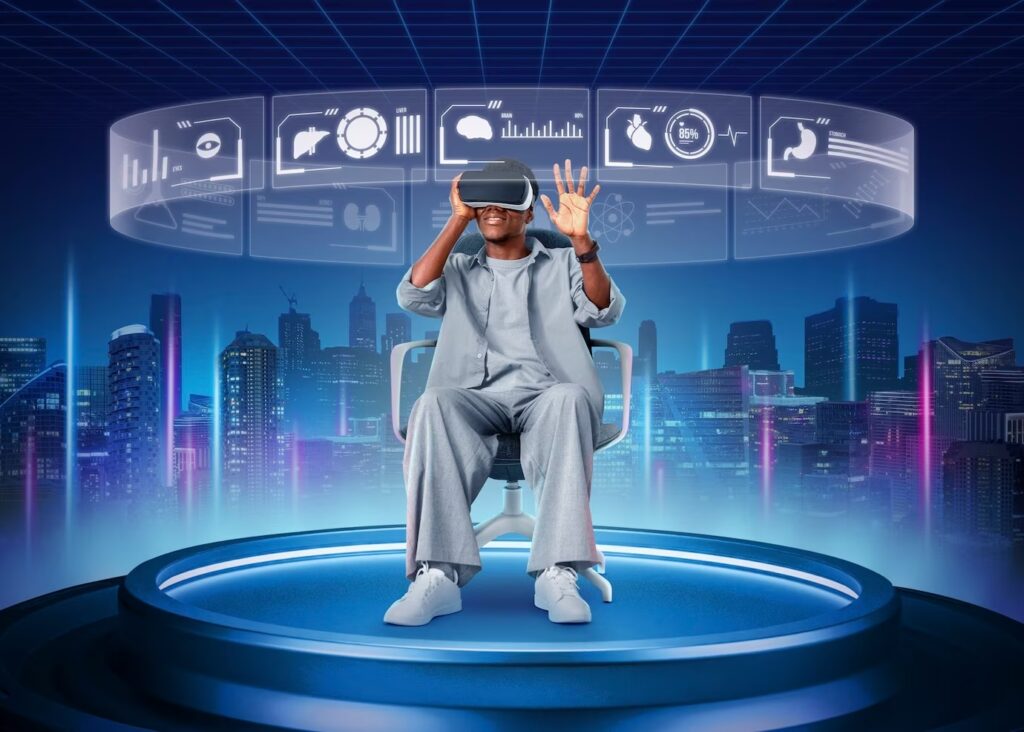
Virtual Reality (VR) has transcended the realms of science fiction and become an integral part of our digital landscape. From the immersive experiences it offers to the diverse applications in various industries, VR has evolved into a technology that shapes the way we perceive and interact with the virtual world.
1. Introduction to Virtual Reality
1.1 Definition and Concept
At its core, Virtual Reality is a computer-generated simulation that allows users to immerse themselves in a three-dimensional, interactive environment. This technology strives to replicate real-world experiences, creating a sense of presence that transports users to a digital realm.
1.2 Brief History
The roots of VR trace back to the mid-20th century, with the concept evolving alongside technological advancements. Early VR attempts were rudimentary, but the 21st century witnessed a surge in development, leading to the sophisticated VR experiences we have today.
2. How Virtual Reality Works
2.1 Hardware Components
VR relies on a combination of hardware components, including headsets, sensors, and controllers. These devices work together to track the user’s movements, creating a seamless and immersive experience.
2.2 Software and Applications
The software behind VR applications is equally crucial. From realistic simulations to interactive games, VR software plays a pivotal role in delivering captivating experiences.
3. Types of Virtual Reality
3.1 Immersive VR
Immersive VR fully engages users in a virtual environment, shutting out the physical world. Headsets like Oculus Rift and HTC Vive exemplify this category, providing an unparalleled level of immersion.
3.2 Augmented Reality (AR)
AR overlays digital content onto the real world, enhancing the user’s perception without disconnecting them from reality. Popularized by applications like Pokemon Go, AR offers a unique blend of virtual and real-world elements.
3.3 Mixed Reality (MR)
MR combines aspects of both VR and AR, allowing virtual and real-world elements to interact. Microsoft’s HoloLens exemplifies MR technology, enabling holographic experiences within the user’s physical surroundings.
4. Applications of Virtual Reality

4.1 Gaming and Entertainment
VR has revolutionized the gaming industry, providing an unprecedented level of immersion and interactivity. From virtual worlds to simulated adventures, gaming in VR is an experience like no other.
4.2 Healthcare
In healthcare, VR finds applications in medical training, therapy, and even surgical simulations. It offers a safe and controlled environment for professionals to enhance their skills.
4.3 Education and Training
VR has opened new frontiers in education, offering immersive learning experiences. From virtual field trips to complex simulations, it provides a dynamic and engaging educational platform.
4.4 Business and Industry
Industries utilize VR for training simulations, product prototyping, and virtual meetings. This technology enhances efficiency and reduces costs across various sectors.
5. Advantages and Challenges of Virtual Reality
5.1 Advantages
The advantages of VR include enhanced learning, improved training efficiency, and unparalleled entertainment experiences. It allows users to explore environments that may be otherwise inaccessible.
5.2 Challenges
Despite its merits, VR faces challenges such as high costs, technical limitations, and potential health concerns. Overcoming these challenges is crucial for widespread adoption.
6. Future Trends in Virtual Reality
6.1 Technological Advancements
The future of VR holds promises of improved hardware, realistic simulations, and more interactive content. Advancements in haptic feedback and graphics will contribute to an even more immersive experience.
6.2 Potential Impact on Society
As VR continues to evolve, its impact on society will extend beyond entertainment and education. Virtual reality has the potential to reshape how we communicate, collaborate, and experience the world.
7. Virtual Reality and the Everyday Consumer
7.1 VR Devices in the Market
With a growing market, various VR devices cater to different consumer needs. From high-end headsets for gaming enthusiasts to more affordable options, accessibility is on the rise.
7.2 Affordability and Accessibility
As technology advances, VR becomes more accessible to the average consumer. Affordable options and user-friendly interfaces contribute to the democratization of virtual reality experiences.
8. Virtual Reality in the COVID-19 Era
8.1 Remote Collaboration and Events
Amid the pandemic, VR has facilitated remote collaboration and virtual events. From business meetings to social gatherings, VR has bridged the physical gap created by social distancing measures.
8.2 Mental Health Applications
VR has shown promise in mental health treatments, providing therapeutic environments for stress relief and anxiety management.
9. Ethical Considerations in Virtual Reality
9.1 Privacy Concerns
As VR becomes more integrated into daily life, privacy concerns arise. Issues related to data security and surveillance must be addressed to ensure responsible and ethical use.
9.2 Psychological Impact
The psychological impact of prolonged VR use is a topic of concern. Understanding and mitigating potential negative effects on mental health is crucial for the responsible development and use of VR technology.
10. Conclusion
In conclusion, VR is a transformative technology with diverse applications and a promising future. As it continues to evolve, addressing challenges and ethical considerations will be paramount for its widespread acceptance and responsible use.
5 Unique FAQs about Virtual Reality
- Q: Is virtual reality only for gaming?
- A: No, virtual reality has applications across various industries, including healthcare, education, and business.
- Q: Are there affordable VR options for everyday consumers?
- A: Yes, with advancements in technology, there are more affordable VR options available, making it accessible to a broader audience.
- Q: How does virtual reality impact mental health?
- A: Virtual reality can have positive effects on mental health, offering therapeutic applications for stress relief and anxiety management.
- Q: What are the privacy concerns associated with virtual reality?
- A: Privacy concerns in VR include data security and potential surveillance issues, emphasizing the need for responsible use.
- Q: What is the future of virtual reality technology?
- A: The future of VR includes technological advancements, improved hardware, and a broader societal impact beyond entertainment and education.
LIKE WHAT YOU’RE READING?
CHECK OUT SOME OF OUR OTHER GREAT CONTENT HERE
- ARTIFICIAL INTELLIGENCE (AI) – A BEGINNER’S GUIDE
- HOW TO START A CAREER IN ARTIFICIAL INTELLIGENCE?
- WHAT IS MACHINE LEARNING?
- DATA SCIENCE – THE ULTIMATE GUIDE
- HOW AI IS USED IN DIGITAL MARKETING?
- TOP 5 BEST SEO TOOLS(2022)
- TOOLS OF MACHINE LEARNING
- 7 MOST POPULAR TOOLS FOR DEEP LEARNING



